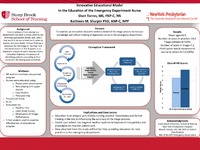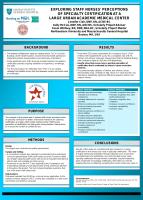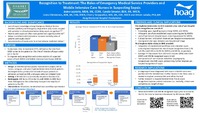| dc.description.abstract | <p>Session presented on Saturday, July 25, 2015:</p>
<p><strong>Background.</strong> Hospitals in recent years have shown an increase in overcrowding in their emergency departments due to hospital closures, lack of primary care and an aging population. Many patients are not receiving appropriate timely care, which may result in delays in treatment, adverse events, and even death. Triage is defined as the process of sorting and prioritizing patients for care (Moller et al., 2010, p.746) Critical thinking is necessary for the triage or 'sorting' and the identification of the ill patient is an important process to avoid adverse events.</p>
<p><strong>Purpose.</strong> The purpose of this study is to demonstrate an innovative education delivery model of the triage process to increase knowledge of registered nurses in the emergency department. This curriculum development will improve knowledge base of nursing staff; improve staff satisfaction and competency of care. Theoretical Framework. The adult learning theory model by Malcolm Knowles is used in this educational program. In this learning theory, Knowles examined adults leaRNs and described the difference from children. Knowles believed education should be adapted to their learning process. Knowles identified 5 charactertics: self-concept, experience, readiness to leaRNorientation to learning and motivation to leaRNThis model can be used in the educational model as they approach learning a problem-based manner through collaboration with educators and leaRN. This approach fosters the learning of the population of interested, emergency department registered nurses. These are adult leaRNs who are required to use critical thinking skills to provide care for patients in need. This learning model is necessary for the education of triage in the emergency department.</p>
<p><strong>Review of Literature.</strong> The review of the literature provides evidence of the Emergency Severity Index (ESI), as refined and validated triage method which helps assess, carefully allocated and plans on the amount of resources needed to care for patients. Studies showed that triage nurses are often faced with many challenges such as lack of formal training, high patient volume, staffing, rate of ED occupancy, inpatient bed availability, interruptions, and lack of privacy. (FeRNes et al., 2005) Many studies proved formal education, emergency nursing experience for new triage nurses, and positive reinforcement from management for timely and accurate decision making showed positive outcomes for patients and staff satisfaction. (Cone and Murray, 2002) Standardized training for assessment, documentation, and ESI implementation is critical to provide consistent care. (Dateo, 2013) Several studies have continued to recognize a combination of education in simulations, thinking aloud, reflection, and incorporation of decision rules lead to a more accurate triage decisions. (Cioffi, 1999)</p>
<p><strong>Methods.</strong> Nurse Practitioner will educate Registered Nurses in the emergency department on the evidence-based practice of 5 tier triage system. Education will occur via mix educational methods of a PowerPoint presentation, role-play with use of paper models, case study and preceptorship. This will be a prospective or cohort study to study the effect of nurse practitioner led educational program for registered nurses. A convenience sample of (n=30) will be used. Registered nurses will perform two exams one prior education intervention and a post-test after intervention. They will also complete a survey via Likert scale to evaluate satisfaction and effectiveness of program. Finally, participants will be observed for accuracy of triage of patients in the Emergency Department to complete necessary compentency of care of patients. Throughout the entire educational process registered nurses will be able to ask questions and be involved in an open discussion forum. Nurses will be allowed to debrief events in case studies and observational assessments of patients. Evaluation of program will occur through post-test, survey of program, appropriate triage level and disposition of patient.</p>
<p><strong>Results.</strong> Pending. Preliminary data suggests improvement in nurses' knowledge of triage system and satisfaction in program.</p>
<p><strong>References:</strong> Aloyce, R., Leshabari, S. & Brysiewicz. (2014) Assessment of knowledge and skill of triage amongst nurses working in the emergency centres in Dar es Salaam, Tanzania. African JouRN of Emergency Medicine, 4, 14-18. Benner P & Tanner C. (1987) How expert nurses use intuition. JouRN of American Nurse, 1, 23-31. ByRN G., Richardson, M., Brunsdon, J., & Patel, A. (2000). Patient satisfaction with Emergency Nurse Practitioners in A&E. JouRN of Clinical Nursing, 9, 83-93. Cone, K., & Murray, R. (2002). Characteristics, insights, decision-making and preparation of ED triage nurses. JouRN of Emergency Nurse, 28, 401-406. Cooper, R.J., Schriger, D.L., Flaherty, H.L., Lin, E.J., & Hubbell, K.A., (2002). Effect of vital signs on triage decisions. Ann. Emerg. Med. 39, 223-232. Cole, F. L., & Kleinpell, R. (2006). Expanding acute care nurse practitioner practice: focus on emergency department practice. JouRN of the American Academy of Nurse Practitioners, 18, 187-189. Cole, F. L., Ramirez, E., & Luna-Gonzales, H. (1999). Scope of practice of nurse practitioners in emergency care. Emergency Nurse Association. Centers for Disease Control and Prevention. (2011). National Hospital Ambulatory Medical Care Survey: 2008 emergency department summary. Retrieved from http://www.cdc.gov/nchs/data/ahcd/nhamcs_emergency/nhamcsed2008.pdf. Croskerry, P., Abbass, A., & Wu, A.W.(2010). Emotional influences in patient safety. JouRN of Patient Safety. 6, 199-205. Dateo, J. (2013). What factors increase the accuracy and inter-rater reliability of Emergency Severity Index among Emergency nurses in triaging adult patients? JouRN of Emergency Nursing. 39, 203-207. Edwards, B. & Sines, D. (2008) Passing the audition - the appraisal of client credibility and assessment by nurses at triage. J. Clin.Nurse. 17, 2444-2451. Emergency Nurses Association. (2010). Triage credentialing policy. Retrieved from: http://www.ena.org/membership/document_share/Pages/default-Triage.aspx. Fry M. & Stainton C. (2005). An educational framework for triage nursing based on gatekeeping, timekeeping and decision-making processes. Accid Emerg Nurs, 13, 214-219. Gilboy, N., Tanabe, P., Travers, D. A., Rosenau, A. M., & Eitel, D. R. (2005). Emergency Severity Index, Version 4: Implementation Handbook. (Fourth ed.). Rockville, MD: Agency for Healthcare Research and Quality. Hsia, R., Kellerman, A., & Shen, Y. (2011). Factors associated with closures of emergency departments in the United States. JAMA, 305, 1978-1985 Kelly A.M. & Richardson D.(2001). Training for the role of triage in Australasia. Emergency Medicine, 13,230-232. Larkin, G. L., & Hooker, R. S. (2010). Patient willingness to be seen by physician assistants, nurse practitioners, and residents in the emergency department: does the presumption of assent have an empirical basis? American JouRN of Bioethics, 10(8), 1-10. Love, R. A., Murphy, J. A., Lietz, T. E., & Jordan, K. S. (2012). The effectiveness of a provider in triage in the emergency department: a quality improvement initiative to improve patient flow. Advance Emergency Nurse JouRN, 34, 65-74. Moller, M., Fridlun, B., & Goransson, K. (2010). Patients' conceptions of the triage encounter at the Emergency Department. Scandinavian JouRN of Caring Sciences, 24, 746-751. Molitor L. (1985). Triage dilemmas and decisions: A tool for continuing education. JouRN of Emergency Nursing, 11, 40-42 Read S, George S, Westlake, L. Wiliam B, Glasgow J & Potter T. (1992) Piloting an evaluation of triage. international JouRN of Nursing Studies, 29, 275-288. Sakr, M., Angus, J., Perrin, J., Nixon, C., Nicholl, J., & Wardrope, J. (1999). Care of minor injuries by emergency nurse practitioners or junior doctors: a randomized controlled trial. Lancet, 354, 1321-1326. Sakr, M., Kendall, R., Angus, J., Saunders, A., Nicholl, J., & Wardrope, J. (2003). Emergency nurse practitioners: a three-part study in clinical and cost effectiveness. JouRN of Emergency Medicine, 20, 158-163. Singer, R.F., Infante, A.A., Oppenheimer, C.C., West, C.A. & Siegel, B. (2012). The Use of and Satisfaction with the Emergency Severity Index. JouRN of Emergency Nursing, 32, 120-126. Smith A.J., & Cone K.J. (2010). Triage decision-making skills: a necessity for all nurses. JouRN of Nurse Staff Development, 26, 14-19. Steiner, I. P., Nicholas, D. N., Blitz, S., Tapper, L., Stagg, A. P., Sharma, L., & Policicchio, C. (2009). Impact of a nurse practitioner on patient care in a Canadian emergency department. Canadian JouRN of Emergency Medicine, 11, 207-214. Wilson, A., & Shifaza, F. (2008). An evaluation of the effectiveness and acceptability of nurse practitioners in an adult emergency department. international JouRN of Nursing Practice, 14, 149-156. The National report care on the state of emergency medicine: evaluation the emergency care environment state by state. (2009). US GoveRNnt Accountability Office. Hospital emergency departments: crowding continues to occur, and some patients wait longer than recommended time frames. Retrieved from http://www.gao.gov</p> | en |





